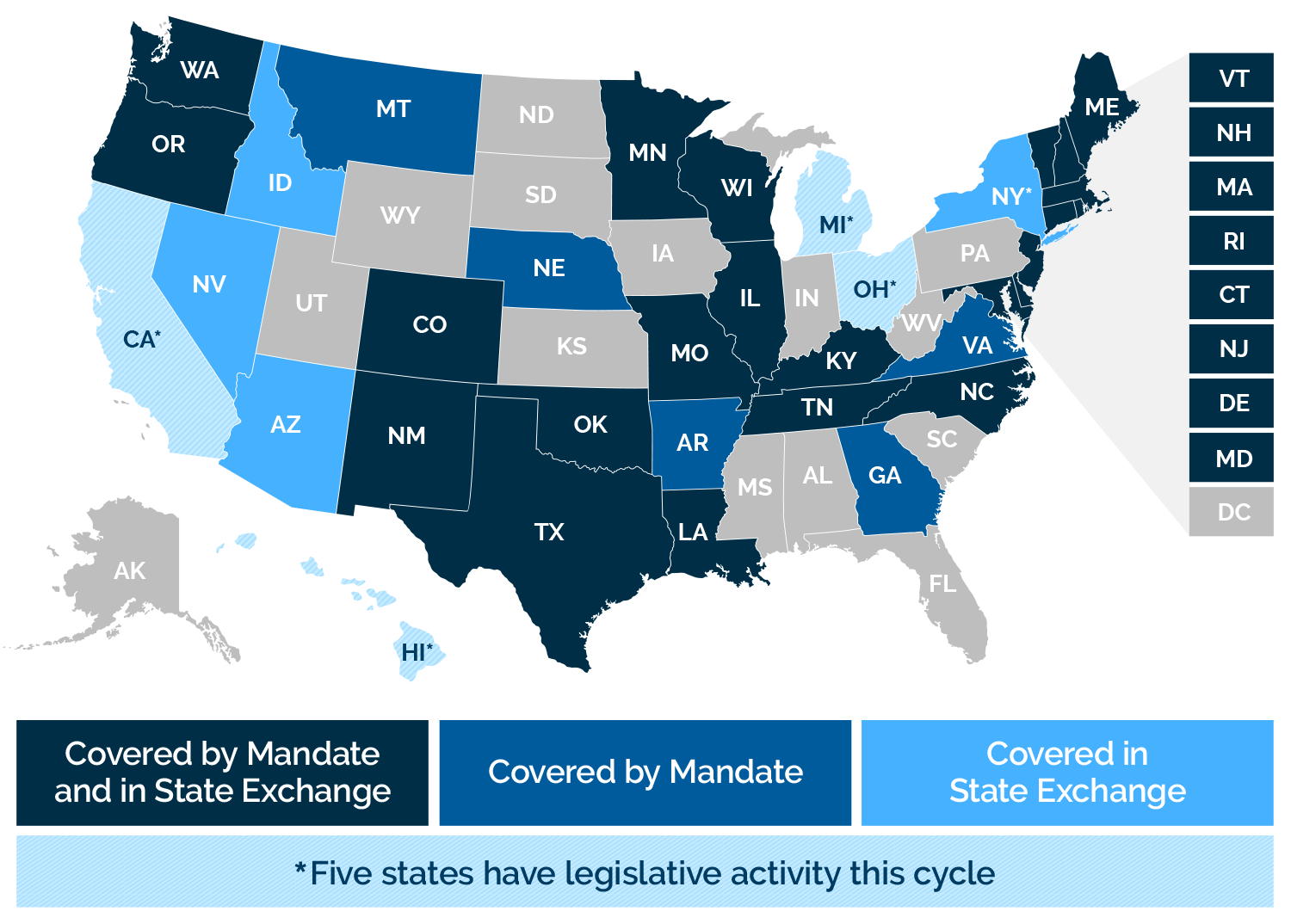State-specific Details
Status of coverage across states in the U.S.


35 States Require Private Coverage of Children’s Hearing Aids
Thirty-five states require private individual and group health insurance plans to cover children’s hearing aids and services through a mandate, their state exchange that includes it in their essential health benefit benchmark, or both.
California may be joining them soon!
In 2026, there will be a total of:
- 24 states that require hearing aid coverage for children with health insurance purchased both outside and within the state exchange marketplaces (Colorado, Connecticut, Delaware, Illinois, Kentucky, Louisiana, Maine, Maryland, Massachusetts, Minnesota, Missouri, New Hampshire, New Jersey, New Mexico, North Carolina, North Dakota, Oklahoma, Oregon, Rhode Island, Tennessee, Texas, Vermont, Washington, and Wisconsin).
- 6 states that have hearing aid coverage mandates that apply to insurance purchased outside the state’s exchange marketplace (Arkansas, Georgia, Montana, Nebraska, Ohio, and Virginia); and
- 5 states that require hearing aid coverage only for insurance purchased within their exchange marketplace, as part of the state’s Essential Health Benefits (EHB) benchmark selection (Alaska, Arizona, Hawaii, Nevada, and New York).
Of the 35 states requiring hearing aid coverage for children in 2026: 30 states have mandates in their private markets, 29 states include hearing aids in their state exchange EHB, and 24 states cover children’s hearing aids in both markets.
Mandates cover state-regulated private plans; EHB inclusion requires all ACA exchange plans in that state to cover children’s hearing aids—requiring both reaches more children.
Several states have been active in filling the insurance market gaps in children’s hearing aid coverage: [1]
- NEW! In 2023, California Governor Newsom vetoed SB 635, the Let California Kids Hear Act, which had unanimous legislative support and would have required hearing aid coverage for over 20,000 children both outside and within the exchange. However, upon further stakeholder input, in May 2025, California applied for federal approval to update its EHB benchmark to include hearing aids & exams (and other benefits) starting in 2027.[2] The new benefits are pending approval by the HHS Secretary, Robert Kennedy, with a decision expected before December 2025. Corresponding state legislation (SB 62 and AB 224)would codify the updated benchmark if approved by HHS.
- NEW! In January 2025, Ohio Governor DeWine signed Madeline’s Law (House Bill 315, previously HB 152), which requires health insurance plans to cover $2,500 per hearing aid every four years for children under age 22, effective April 2025.
- In 2024, Alaska received federal approval to update its EHB benchmark plan for 2026 to include coverage for annual hearing exams and hearing aids every three years.
- In Virginia, Governor Youngkin signed SB 1003, which requires coverage for hearing aids for children under the age of 19, effective January 1, 2024.
- In Washington, Governor Inslee signed two pieces of legislation: HB 122, which mandates hearing aid coverage outside the exchange marketplace starting in 2024, and SB 5338, directing consideration of changes within the exchange marketplace. In 2024, the state received federal approval to update its EHB benchmark plan for 2026 to cover an annual hearing exam and one hearing aid per ear every three years.
- In 2023, North Dakota received federal approval to update its EHB benchmark plan for 2025 to include one hearing aid per ear every 36 months.
A few states have limited state-directed hearing aid assistance programs for children, yet many have struggled or fallen short in serving the kids.
- California created the Hearing Aid Coverage for Children Program (HACCP) in 2021 for children under 600% FPL. It is administered by the state Medicaid agency (Department of Health Care Services), and only 257 individuals under the age of 21 are currently enrolled.
- Indiana (2014), Iowa (2007), Missouri (2019), and Wyoming (2012) have had narrow hearing aid assistance programs in place for many years. In 2021, Utah created the Children’s Hearing Aid Program (CHAP) for children six and under with family incomes below 300% FPL, and in 2023, Florida created a program designed to assist in obtaining hearing aids and other hearing technologies for children residing in Florida aged 0-18 under 400% of the FPL. After having limited success with a state-administered program, Georgia passed a mandate in 2018.
This analysis was prepared by Children Now and Let California Kids Hear building on previous research by: Centers for Medicare & Medicaid Services (CMS), Center for Consumer Information and Insurance Oversight (CCIIO); Hearing Loss Association of America; American Speech-Language-Hearing Association; American Academy of Audiology; National Center for Hearing Assessment and Management; and A. Grace, et al., as published in Health Affairs.
[1] Relevant legislation has also been introduced in Hawaii (SB 609 and HB 818), Michigan (HB 4944 and HB 4963), New York (A03023 and S4929), and Wyoming (SF0089). Other recent state hearing aid coverage changes include: In 2022, Mississippi law removed an exclusion of hearing aids for children in insurance. In 2020, an Idaho regulatory change clarified that hearing aids for children are not excluded from coverage. In 2023, Illinois passed HB 2443 which expands hearing aid coverage to adults.
[2] Other benefits added include mobility devices and fertility treatment; see press release.
